The Ultimate Guide to Building a High-Ticket Agency Funnel in 2025
This post is all about creating and optimizing a high-ticket agency funnel to attract the right clients and boost conversions.
High-value products and services can be challenging to sell. The secret is creating a high-ticket agency funnel to target the right clients and using strategic selling tactics.
As a marketing company that has helped dozens of brands drive high ticket sales, Single Grain understands this. That’s why we use the latest SEO and marketing tactics to generate a 300% ROI for our clients.
TABLE OF CONTENTS:
Optimize for the High-Ticket Agency Funnel
Optimizing your strategy for the high-ticket funnel is the key to success. Here’s why this tactic is effective and how you can use it for your organization.
The Four Pillars of an Effective High-Ticket Agency Funnel
Building a successful marketing funnel involves focusing on four key elements:
- Product: Ensure your offering is clear, valuable, and solves a specific problem.
- Audience: Understand the thoughts, feelings, needs, and aspirations of your high-ticket customers. Tailor your messaging to their stage of business growth.
- Offer: Create an irresistible gateway offer that builds trust and showcases your value.
- Funnel: Use simple, logical steps to guide prospects from interest to conversion.
Traditional marketing follows this approach: a lead enters through the top funnel and becomes interested in the product or service. As they dive deeper into the topic, they become customers.
How does the high-ticket agency funnel differ? Client acquisition is more advanced. Many companies using this strategy are SaaS companies, and they rely on retaining subscribers. The key is to continue driving demand by ensuring your product or service solves problems, understanding your audience’s needs, and consistently creating great offers.
Simplifying Funnel Architecture
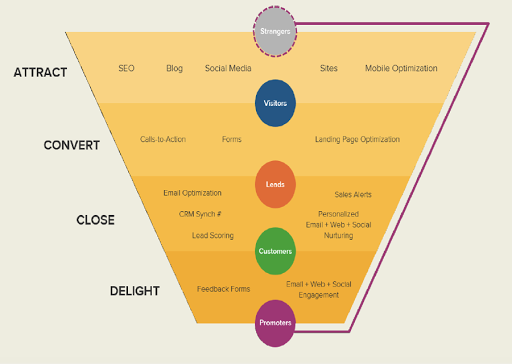
Source: SAPBW Consulting
While advanced strategies are valuable, simplicity often yields the best results. Simplifying the sales funnel is the best way to optimize your strategy for sales growth.
A straightforward funnel might include:
- A landing page with a clear call to action.
- A cart page for easy checkout.
- Logical upsells and order bumps to maximize revenue.
- Follow-up email sequences to nurture leads and encourage repeat business.
For instance, a $27 ebook can lead to an upsell for a $97 program, followed by a $497 course. This step-by-step approach ensures that each interaction builds on the last, increasing the lifetime value of each client.
How can you simplify your sales funnel? This may vary by business. Some may find a standard sales funnel the most straightforward solution, while other brands may have a different pipeline. The key is to use data to find the best solution for you, which we will cover next.
The Role of Data in Funnel Optimization
Optimizing your sales funnel starts by interpreting and analyzing data from past campaigns. Examples include metrics from past sales funnel strategies, market trends, and customer preferences and behaviors.
With this data, you can:
- Identify bottlenecks in your funnel.
- Adjust targeting and messaging for better results.
- Ensure a positive return on ad spend (ROAS).
How can you use data to measure sales funnel performance? Integrate automation tools like Zapier with your CRM to pull valuable data from lead forms and provide your sales team with actionable insights.
The High-Ticket Sales Funnel in Action: Introducing the Ascension Path Model
The Ascension Path Model is a marketing framework that is an alternative to pushy sales strategies. This model focuses on monetizing knowledge instead of relying on product sales, ensuring every sales funnel stage is profitable.
The Ascension Path Model segments potential clients based on their awareness and readiness to purchase. The process begins with a Gateway Offer—a low-barrier entry point that introduces prospects to your brand and builds trust. These offers can be:
- Free or paid events: Workshops or webinars that provide immediate value.
- Challenges: Short-term programs designed to solve a specific problem.
- Webinars: Educational sessions that demonstrate expertise.
- E-books or guides: Downloadable content that addresses a pain point.
- Lead magnets: Free resources that appeal to your target audience, such as templates or checklists.
What Are Gateway Offers?
A gateway offer serves as the first point of contact for potential customers—a low-cost, high-value product designed to introduce them to your brand while fostering trust. The idea is to provide customers with a sample of your expertise, encouraging them to invest further in your products or services.
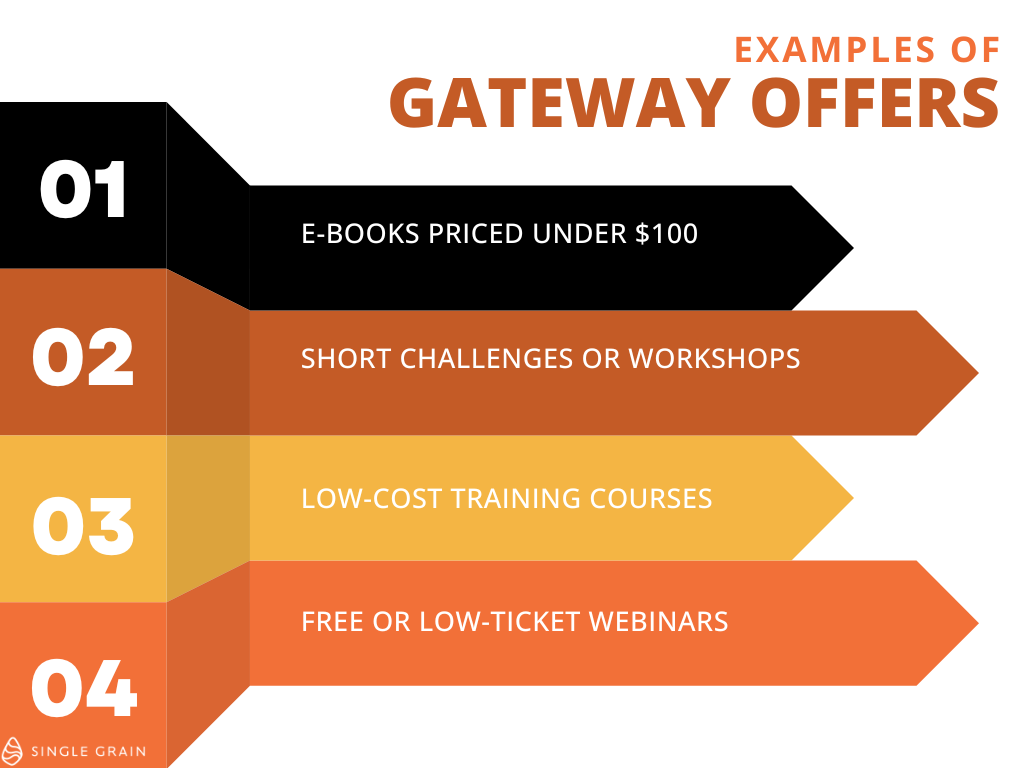
In practice, gateway offers can take many forms:
- E-books priced under $100
- Short challenges or workshops
- Low-cost training courses
- Free or low-ticket webinars
These offerings allow businesses to bring in leads while creating a positive first impression, nurturing them into higher-ticket purchases over time.
Segmenting Offers for Different Audiences
One size doesn’t fit all when it comes to gateway offers. Different customers respond to varying approaches, which is why it’s wise to segment various lead subgroups. This helps deliver tailored messaging to the best leads.
What are some examples of offers you can deliver to segmented audiences? Examples include:
- Webinars: Attract time-sensitive leads with webinars, typically converting to mid-tier offers.
- Content: If your leads have more time but limited budgets, offer do-it-yourself courses or affordable gated content.
- Free or low-cost products: Build a foundation of trust with lower-priced offers, creating a pathway to higher-priced services.
Creating the Ultimate Funnel: Combining Gateway Offers
You can tailor your existing sales funnel to implement various gateway offers. Here’s an example of what that would look like:
- Top of the funnel: Free lead magnets like guides or community access.
- Mid-tier: Paid products like e-books or training courses.
- Bottom of the funnel: Agency services or premium coaching programs.
For example, an agency offered a $44.90 paid challenge with a $49 VIP upsell, which allowed them to break even on the front end while achieving a 16X return on the back end. This funnel targeted freelancers, coaches, and consultants, offering a clear Ascension path toward premium products.
Building Your Ascension Path
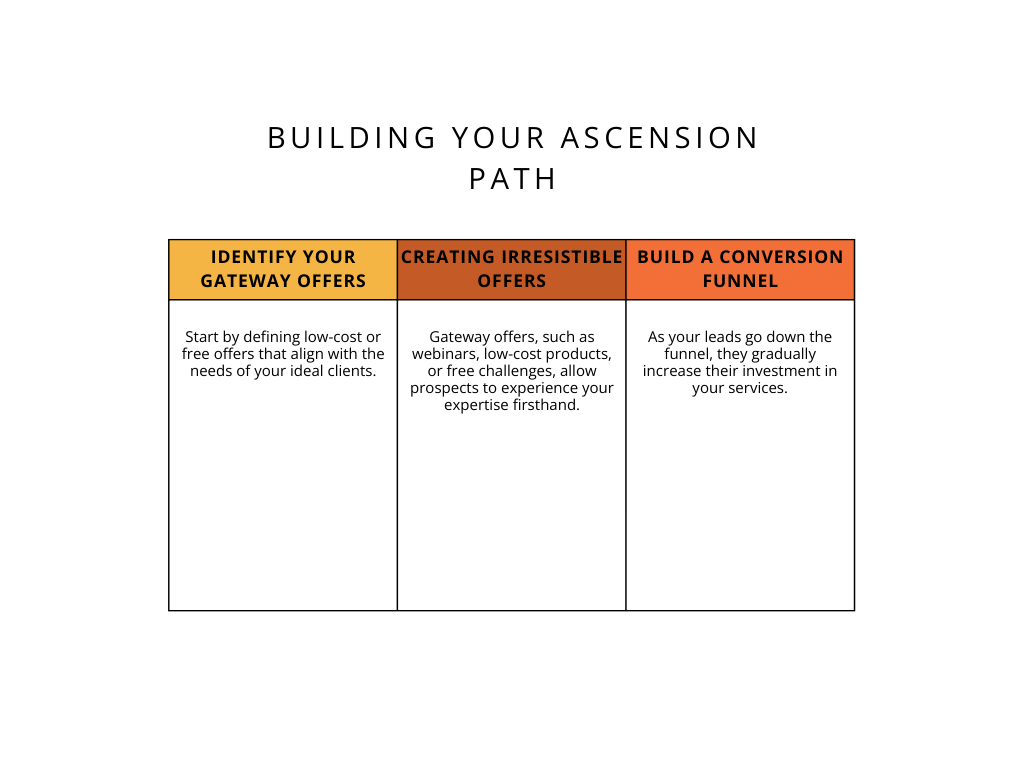
Here’s how to implement the Ascension Path Model in your agency:
Identify Your Gateway Offers
Start by defining low-cost or free offers that align with the needs of your ideal clients. These could be guides, templates, webinars, or even audits. The goal is to attract prospects into your ecosystem with minimal friction.
Creating Irresistible Offers
The “Know, Like, and Trust” (KLT) bridge is a key to high-performing funnels. This approach involves nurturing prospects with valuable content before presenting your core offer. Gateway offers, such as webinars, low-cost products, or free challenges, allow prospects to experience your expertise firsthand.
This content also shows them the benefits of working with your agency, and your final offer will be more irresistible. When they reach the decision-making stage, they trust your brand and are more likely to convert.
Build a Conversion Funnel
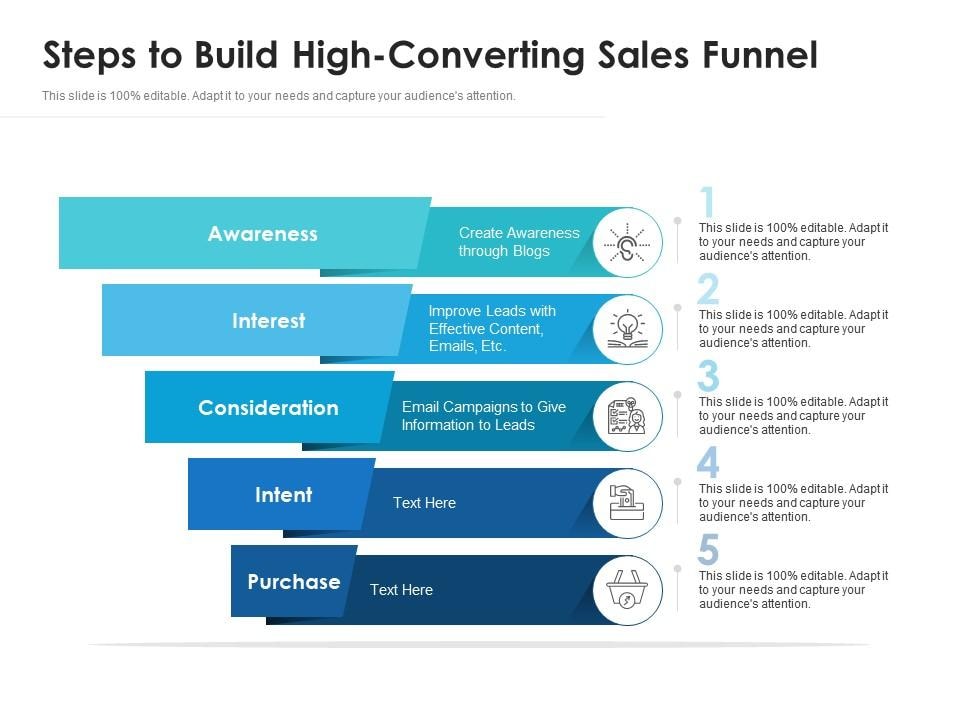
Source: Slide Team
Once prospects engage with your gateway offer, draft a customer journey plan that guides them through several steps. As your leads go down the funnel, they gradually increase their investment in your services.
For example:
- Start with customer-focused content, such as a free e-book.
- Qualify leads with a sign-up form.
- Offer a paid webinar or workshop.
- Upsell to a low-cost audit or consultation.
- Present your full-service solution.
Monitor your performance by tracking essential metrics, such as conversion rates. This way, you can find potential leaks in your sales funnel.
Tactics for the High-Ticket Agency Funnel
There are other strategies that can engage B2B clients and drive awareness to high-ticket products and services. From lead magnets to Facebook ads, here are other core tactics that you can add to your sales funnel or Ascension Path Model.
Facebook Ads
Facebook ads can help a high-ticket agency get more visibility when organic posts aren’t cutting it, and there are many ways to add a social media advertising strategy to a high-ticket sales funnel. Brands can either boost existing Facebook posts to attract more website traffic or create ad copy to increase impressions and CTRs.
The key to using Facebook ads to boost the high-ticket agency funnel is to master the nuances of the algorithm. The algorithm rewards advertisers who deliver a great user experience and align with users’ needs.
To generate leads from Facebook ads, focus on creating quality creatives, target relevant leads, and optimize your funnel for social media advertising.
Transforming Sales Conversations
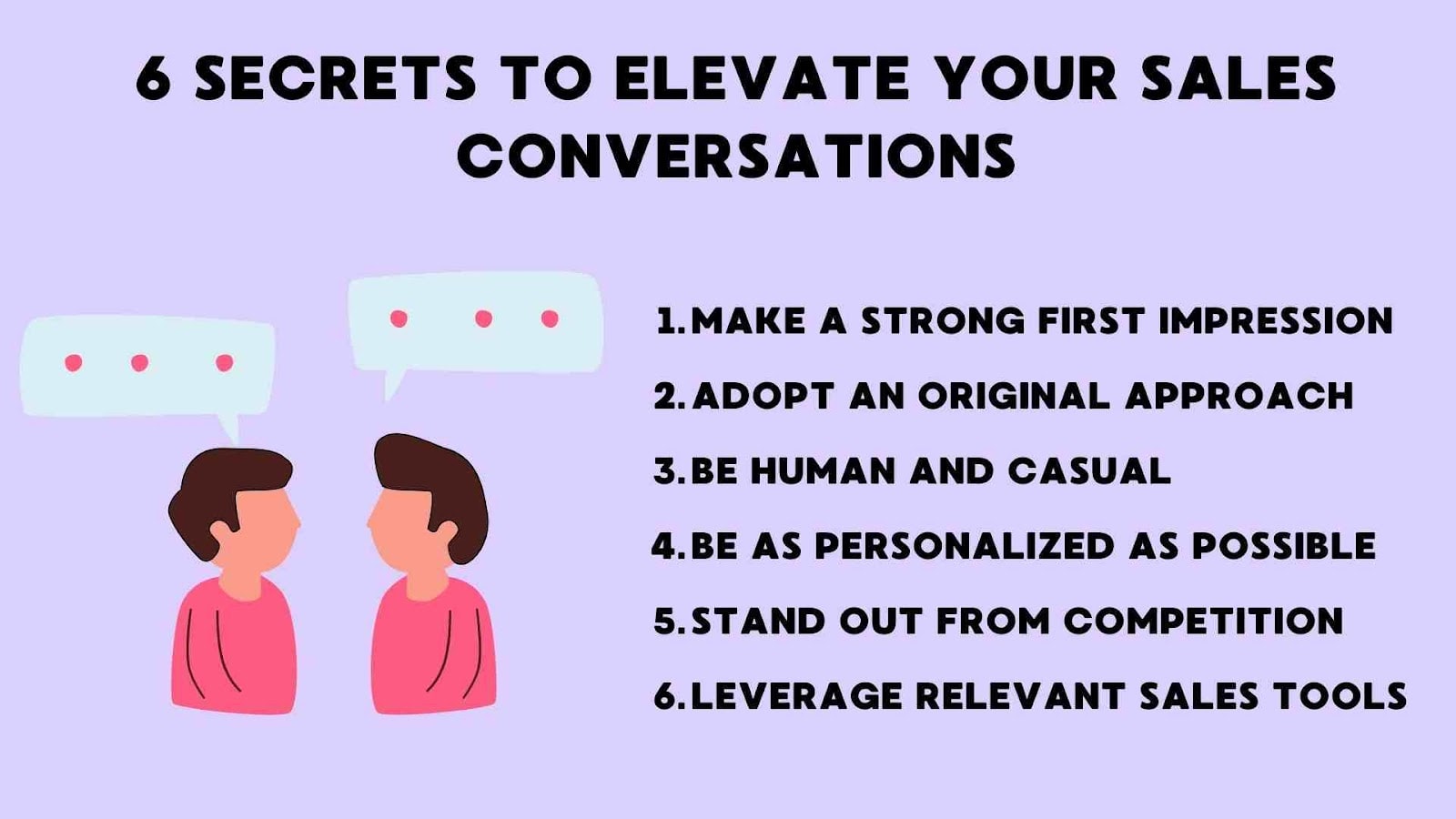
Source: Claap
The ultimate goal of any gateway offer is to build trust and rapport with potential customers before a sales call. But how can brands achieve this? The key is to personalize all content and sales interactions.
Research your ideal buyer rather than casting a wide net on general leads. Understand their business needs and niche trends and find a solution to their problems.
Reel these leads in with free or low-cost content. After consuming your content, your leads will be familiar with your expertise and products/services.
This changes the dynamic of sales calls. Instead of pitching your services, you’re discussing how you can help them achieve their goals. As a result, your leads are more likely to convert, as they’ve already bought into your methodology.
This approach eliminates the need for cold outreach, creating a steady pipeline of warm leads eager to work with your business.
Leveraging Programmatic Conversion Rate Optimization (CRO)
Programmatic conversion rate optimization (CRO) can generate more sales or other desired actions from your website or app, making your high-ticket sales funnel more accurate and effective. Brands can use technology to:
- Optimize website conversions dynamically.
- Tailor messaging for visitors using AI-driven tools.
- Automatically update SEO elements to maintain relevance and drive organic traffic.
These tools improve user experiences and ensure your marketing efforts are data-driven and scalable.
The Power of Video Funnels
87% of businesses say that video marketing improved their lead generation. Brands can take their high-ticket agency strategy further by implementing video funnels.
Video content offers these benefits to your sales funnel:
- Attracting more leads
- Engaging and nurturing leads at all stages
- Fostering customer loyalty after converting
Video funnels can be a game-changer, but the key is to use tailored messaging by audience segments. With this strategy, you can:
- Retarget viewers who engage with your content.
- Move potential clients from awareness to action without relying on traditional tracking methods.
- Use lead forms directly on platforms like Facebook to capture data seamlessly.
The key to targeting your audience with video funnels is to find an alternative to pixel. 9 out of 10 Americans think that online privacy is an important issue, so tracking online activity during the initial funnel stages may dissuade leads more than engage them.
The key is to generate pixel-less leads and target them with video content. You can do this by crafting themed video content targeting specific pain points—like “freelancer struggles” or “agency growth challenges.” Retarget those viewers with relevant offers, such as booking a free call or exploring premium services. This further streamlines the funnel while adhering to privacy laws and preferences.
Paid vs. Free Lead Magnets
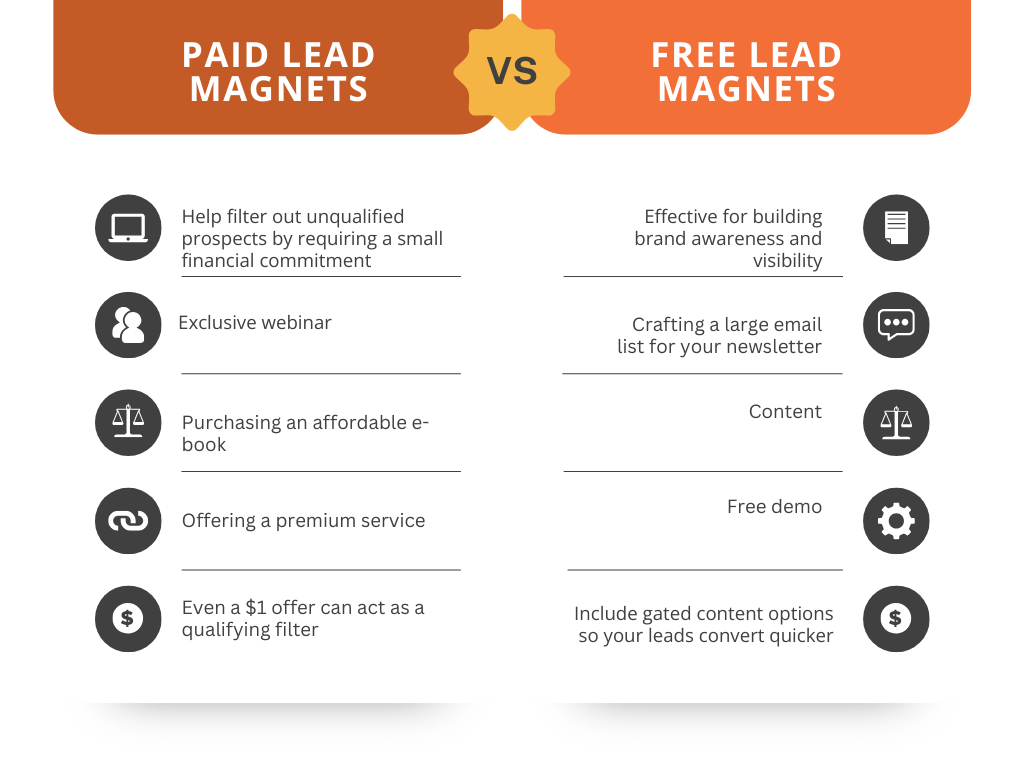
There’s a difference between leads who accept freebies and others willing to pay a small amount for gated content, demos, or a webinar. Most B2B agencies will attract better leads when offering a paid service, but free lead magnets also have their place in marketing. Here’s a comparison between the two:
- Free lead magnets: Effective for building brand awareness and visibility, such as a free demo or crafting a large email list for your newsletter.
- Paid lead magnets: Help filter out unqualified prospects by requiring a small financial commitment, such as purchasing an affordable e-book or offering a premium service. Even a $1 offer can act as a qualifying filter.
High-Ticket Strategy Best Practices
Achieving your high-ticket sales goals is knowing some secrets of this strategy. These include understanding your audience, avoiding common pitfalls, and tracking the right metrics.
Why Targeting the Right Clients Matters
Understanding your target market is essential to any strategy, but it is a make-it-or-break-it for high-ticket funnels.
Marketers must understand their preferences, needs, and behaviors to target the right clients. Marketers can optimize this data for sales funnel marketing, delivering the right message at every pipeline stage. When clients feel understood, they’re more likely to trust your expertise.
Understanding high-value clients can help businesses:
- Justify premium pricing for comprehensive services such as ads management, funnel creation, email marketing, and tech integrations.
- Deliver exceptional results by allocating resources effectively.
- Build mutually beneficial relationships where both parties see tangible returns.
When you work with clients who value your services and are willing to invest in them, you create a win-win situation that enhances client satisfaction and allows your agency to thrive.
Adapting to Client Life Stages
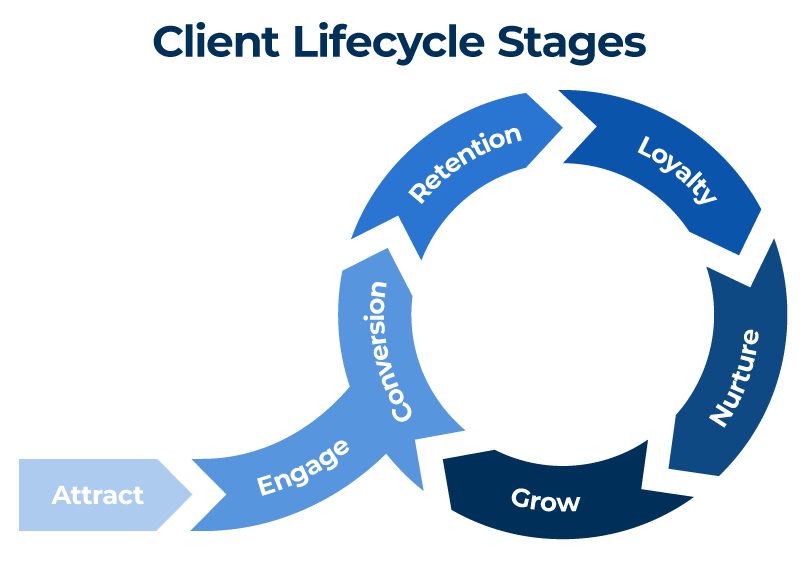
Source: Smartsheet
The traditional sales funnel highlights the key stages a prospective customer goes through to become a customer, from brand awareness to making that first purchase. However, this sales funnel looks different when targeting B2B clients. Plus, your clients’ needs evolve as they progress in their business journey.
Understanding the various business life stages helps you create targeted offers. For example:
- Startup: Free resources and low-cost products.
- Growth: Group coaching and scalable solutions.
- Scaling: High-touch, done-for-you services for premium clients.
Remember that this sales funnel may differ based on your products/services, niche, and more. That means your sales funnel may be shorter and simpler or longer and more complex than this.
Start by segmenting your audience based on their business stage so you can deliver personalized solutions that resonate deeply with their current challenges and goals. We will discuss segmenting your audience in a later section.
Avoiding Common Pitfalls
Every business faces setbacks, even when implementing the high-ticket sales funnel. Some common ways that agencies initially struggle are:
- Undervaluing services to win clients.
- Attracting prospects that aren’t a good fit.
- Lacking a clear direction.
In addition to learning from past mistakes, excellent communication with clients and staff members, clear objectives, flexibility, and a risk management strategy can address these challenges. After implementing the high-ticket sales funnel and the Ascension Path Model, agencies can:
- Attract clients who value your agency and expertise.
- Charge fees that reflect the value you’re delivering.
- Scale your agency while maintaining high profitability.
The Importance of Tracking and Analysis
Tracking core metrics is integral across all sales funnel stages. However, monitoring KPIs can also be challenging for the high-ticket sales funnel. If you have various funnels or numerous customer segments, you may fail to identify efficiencies and other areas of improvement.
The key is to scale your best-performing campaigns. This can include your content, events, and advertising strategies.
If you properly track and optimize your efforts early in your campaign, you can allocate resources effectively and achieve great results.
Key Metrics to Monitor
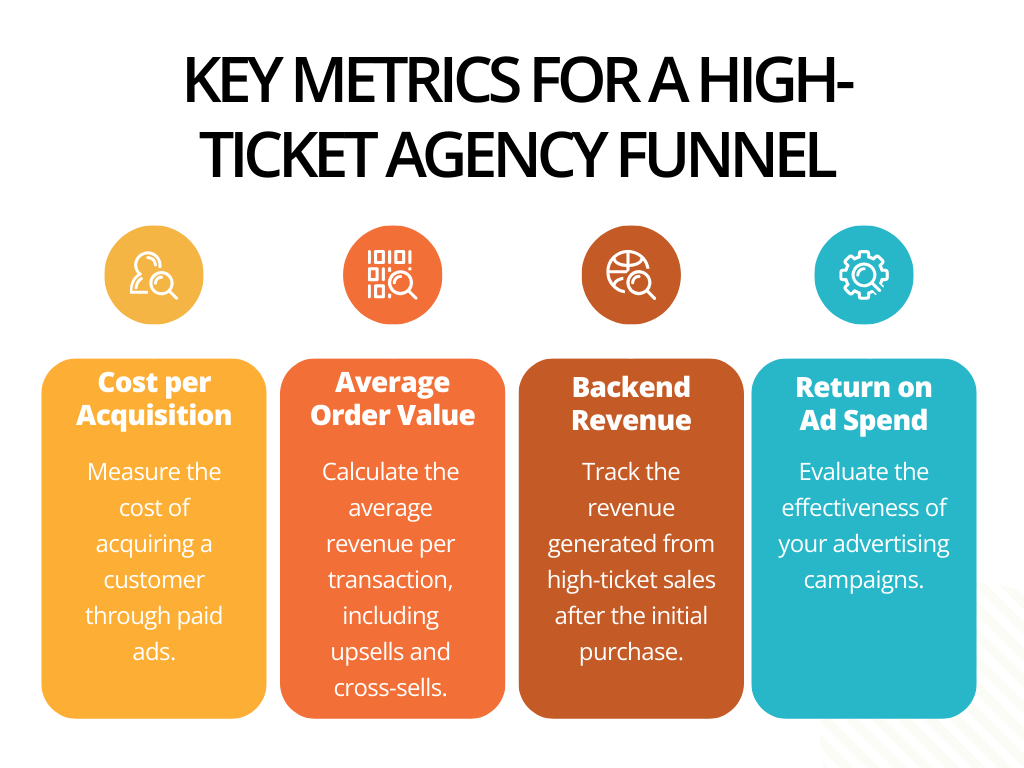
All organizations may track different metrics, depending on your objectives and sales funnel. Here are some examples of metrics to track:
- Cost per Acquisition (CPA): Measure the cost of acquiring a customer through paid ads.
- Average Order Value (AOV): Calculate the average revenue per transaction, including upsells and cross-sells.
- Backend Revenue: Track the revenue generated from high-ticket sales after the initial purchase.
- Return on Ad Spend (ROAS): Evaluate the effectiveness of your advertising campaigns.
Monitoring these metrics also helps agencies scale their efforts confidently and make data-driven decisions.
We Can Help You Build Your High-Ticket Agency Funnel
The key to selling high-value products and services is using a campaign targeting the best leads. Businesses can do this by optimizing their campaign for the high-ticket agency funnel and applying the Ascension Path Model.
While these two strategies differ, they have one leading quality: businesses must create content proving their products or services are valuable and solve their prospect’s problems. If you’re struggling to tailor this message to your audience, it’s time to call the experts for help.
Single Grain Marketing can build a customized marketing funnel optimized for conversions. We can craft a sales funnel for high-ticket agencies that nurture leads until they’re ready to purchase. Click here to learn more about our marketing funnel services.
If you’re ready to level up your high-ticket sales strategy, Single Grain’s marketing experts can help!👇
Related Video
For more insights and lessons about marketing, check out our Marketing School podcast on YouTube.
Frequently Asked Questions on High-Ticket Agency Funnels
-
What is a high-ticket agency funnel and how is it different from a traditional sales funnel?
A high-ticket agency funnel is a simple, trust-first path that moves qualified prospects toward premium services. Unlike a traditional, volume-driven funnel, it segments by awareness and readiness, uses a gateway offer to build KLT, and profits at each step via a value ladder. Think landing page → cart → logical upsell/order bump → nurture emails, with conversion rate, lifetime value, and ROAS guiding decisions.
-
How do I build a high-ticket funnel that stays simple but converts?
Start lean: one focused landing page, a clear CTA, a frictionless cart, and 1–2 logical upsells or an order bump. Pair it with a short nurture sequence and retargeting. Use a value ladder (e.g., $27 guide → $97 workshop → $497 intensive) to lift lifetime value. Track conversion rate and ROAS weekly, iterate with small tests, and resist adding steps that don’t move the needle.
-
What stages should a high-ticket sales funnel include for agency services?
You’ll typically see: 1) Awareness via a targeted lead magnet or video, 2) a gateway offer (paid workshop, challenge, or mini-course), 3) a mid-tier audit/consultation, and 4) the core engagement. Layer in nurturing emails, retargeting, and a CRM-driven follow-up. This Ascension Path Model lets you qualify by readiness while improving conversion rate and lifetime value at each step.
-
What’s a gateway offer in a high-ticket agency funnel, and what should it cost?
A gateway offer is a low-friction, high-value intro that builds trust before your premium service. Price it low (often under $100)—think $27 ebook, $44.90 challenge with a $49 VIP upsell, or a modestly priced webinar. Aim to at least break even on the front end, then recoup profit via your value ladder, follow-up emails, and a well-timed consultation offer.
-
How do I use data to optimize my high-ticket agency funnels for better ROAS?
Instrument everything. Pipe lead-form data into your CRM via Zapier, track conversion rate by step, and segment messaging by readiness. Review ROAS, lifetime value, and drop-off points weekly to spot bottlenecks. Then run programmatic CRO tests on headlines, CTAs, and offer sequencing. Small wins—like a cleaner cart or tighter upsell copy—compound fast in a high-ticket sales funnel.
-
What high-ticket funnel strategy works best for segmenting cold vs. ready-to-buy leads?
Use the Ascension Path Model. Send colder audiences to value-rich content or a free lead magnet, then invite them to a low-cost gateway offer. Route warmer leads to paid workshops or an audit. In your CRM, tag by behavior (video views, webinar attendance, order bump acceptance) and tailor follow-ups accordingly. This self-selection lifts conversion rate without pushy sales.
-
How should I structure upsells and order bumps in a high ticket agency funnel?
Keep them relevant and light. Add one order bump on the cart (a checklist or template under $50), followed by 1–2 upsells that accelerate results (e.g., a $97 workshop or a $497 intensive). Make it one-click and clearly outcome-driven. Track take rates and average order value lift; kill anything that hurts conversion rate or distracts from your core service.
-
Which tools help me integrate CRM and automation when I build a high-ticket funnel?
Use a CRM as your source of truth, then connect forms, calendars, and payment pages with Zapier. Automate nurturing with email sequences tied to behaviors (downloads, webinar attendance). Add programmatic CRO tools for rapid testing, and lean on platform lead forms when you need pixel-less tracking. The result: faster feedback loops and higher ROAS.
-
How can video funnels and pixel-less tracking improve my high-ticket sales funnel?
Video funnels warm prospects fast and respect privacy. Use themed videos to address specific pain points, retarget viewers by watch time, and capture details with on-platform lead forms—no pixel required. Then route segments to the right gateway offer. Expect higher engagement, smoother KLT building, and clearer conversion paths without compromising attribution in your high-ticket sales funnel.
-
How long does it take to close clients with a high-ticket agency funnel, realistically?
There’s no universal timeline, because cycle length hinges on buyer readiness and offer complexity. A high-ticket agency funnel shortens decisions by pre-selling with content, a gateway offer, and tailored nurturing. Track conversion rates between steps and time-in-stage in your CRM. Tighten handoffs and automate follow-up so momentum isn’t lost between steps.





